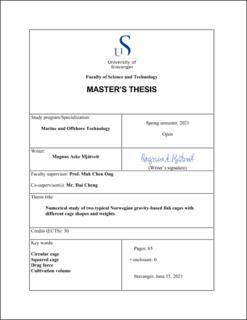| dc.description.abstract | Fish cages usually have net deformation in marine environments, and this deformation can reduce the cultivation volume of the fish cage and thus reduce the fish welfare. Hence, it is necessary to understand the structural responses of fish cages under various environmental conditions. In the present thesis, two hydrodynamic models, i.e., Morison model and Screen model, are implemented into a general finite element (FE) solver Code_Aster as a new module for dynamic analyses of fish cages.
Two typical Norwegian fish cage models with circular and squared shapes are developed in the present study and are employed to compare their structural responses and net deformation. The comparative study of the two fish cages is carried out with different dimensions (i.e., circumferences and design heights), weights and current velocities. Correspondingly, the numerical results from the study are collated and investigated using Python scripts.
Firstly, the drag forces of the two fish cages are compared. The primary difference in drag force is caused by the shapes of the two fish cages, where the circular fish cage experiences a larger cage deformation for strong current velocities than the squared cage. The numerical results indicate that the squared cage induces a larger drag force than the circular cage, when both cages have the same dimensions, weights and current velocities.
Secondly, the total cultivation volume and the volume factor are calculated and compared. When U < 0.4 m/s, the circular cage has a larger cultivation volume than the squared cage for the same dimensions and weight. Overall, the squared cage has a greater volume factor than the circular cage for different dimensions, weight and current velocities. The squared fish cage produces a larger cultivation volume per netting area and volume factor per netting area than the circular fish cage.
Lastly, the fish cage height and cross-section area of the two fish cages are compared. With the same dimensions and weight, the circular cage has a larger fish cage height than the squared cage when U < 0.4 m/s. The circular fish cage has a larger cross-section area than the squared cage when U < 0.5 m/s, given the same dimensions and weight. | |
